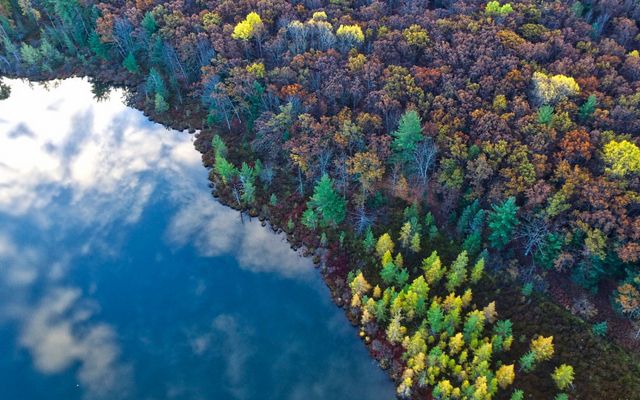Steering the Policy Ship Into a New Decade
A series of international agreements in 2020 could set the stage for more sustainable economies by 2030
By Lynn Scarlett, Former Chief External Affairs Officer
Imagine a massive container ship moving across the ocean at top speed, and on its present course it is headed straight for a rocky island. The island is one mile away—which might seem far off, but turning a large ship moving at high speeds takes considerable effort. There’s still time for the ship to avoid running aground, but only if it starts the turn now.
This is the situation all of us are in today. The imminent collision we face is a world wrecked by climate breakdown and biodiversity loss, and the container ship—well, we’re all on that ship, and the engine of the current global economy is driving us straight toward the rocks.
These are the no-longer hidden costs of economies based on fossil fuels and unsustainable management of natural resources: the impacts of rising temperatures, rising sea-levels and the rapid extinction of species around the world. Businesses are not blind to these costs—some are already seeing them hit their bottom line, not to mention threatening communities around the world. Indeed, many businesses are working to change their operations—but are we making our turn fast enough?
The seminal 1.5°C Degree Report from the UN’s Intergovernmental Panel on Climate Change warned that we face accelerated climate impacts if we don’t drastically reduce emissions by 2030—the same year set for achieving the UN Sustainable Development Goals—and continue with even steeper reductions through mid-century.
That gives us roughly 10 years to put the world on a safer path.
 But economies, like container ships, don’t change course overnight. Creating a sustainable future in 2030 requires us to achieve net zero emissions and implement significant changes across sectors like agriculture and heavy industry at a global scale—starting, essentially, today.
But economies, like container ships, don’t change course overnight. Creating a sustainable future in 2030 requires us to achieve net zero emissions and implement significant changes across sectors like agriculture and heavy industry at a global scale—starting, essentially, today.
How would we do this? We would need all nations to meet their Paris Agreement targets for climate action and then dramatically increase their ambitions, commit to greater biodiversity protection and establish protective regulations and economic incentives to realize these targets.
Ambitious? In fact, we have three convenings this year through which nations can set these goals. (Editor's note: See here the latest on shifts in timing and approach due to the COVID-19 crisis.)
High Time for High Seas Governance
First, in March we’ll see the fourth and hopefully final round of negotiations for a new High Seas biodiversity UN treaty. Why is this so significant? Currently there is little governance of the high seas—the areas outside of national sovereignty, which cover nearly 50 percent of the planet. As a result, the ocean has been badly degraded by largely unregulated human activities.
Overfishing, habitat loss, pollution and the impacts of climate change have pushed marine environments to the brink. And with deep-sea mining and bioprospecting set to accelerate in the next few years, we could expect to see more profound damage in open water environments if such practices are not carefully managed. This would be a catastrophe, as the high seas are home to some of the most wondrous species on our planet, not to mention a crucial source of food for billions of people.
The new High Seas biodiversity agreement, along with new regulations coming out of the International Seabed Authority in July, could finally bring consistency—and enforcement—to the current patchwork of sector-based regulations, and help ensure that the marine world is conserved and not just seen as a bottomless well of resources. With strong treaty text, this could be one of the most important environmental agreements in decades.
A New Deal for Nature
Marine ecosystems in national waters will also be on the docket—along with the rest of the natural world—in Kunming, China in October when the 196 countries that are party to the Convention on Biological Diversity (CBD) gather to finalize a new framework for the global protection of nature. Biodiversity is in a quieter state of crisis than the climate—instead of floods and fires, it manifests as empty fishing nets and fields gone silent because the insects have disappeared. But all these creatures are key to the very systems that make up and keep the planetary ecosystem healthy—if this system is significantly disrupted, we can’t even fathom the full repercussions yet.
The biodiversity targets that get the most attention tend to focus on parks and protected areas—the purview of the environment ministers who typically lead negotiations for the CBD. But the big and necessary opportunity on the road to Kunming is to involve key officials from finance, planning, transportation, energy and agriculture in negotiations for the new framework—people who have the political and economic clout to drive change and integrate the protection of nature throughout political and economic systems.
This is a chance for governments to reassess wasteful and damaging agricultural subsidies, for example, or create incentives internationally for agribusinesses that can prove their imports are produced without converting natural habitats. Similarly, leaders may look to establish more robust planning and mitigation efforts related to energy, transportation, and infrastructure—and establish measurable outcomes for each target, holding accountable businesses and governments alike.


Climate Commitments Come Due
Finally, there is the UN’s annual Climate Change Conference (COP), which Scotland will host in Glasgow this November. This year’s gathering, COP 26, holds particular weight, as countries will be held accountable for the national commitments made in Paris in 2016 and pressed to make new, more ambitious commitments. This could finally start to put the Paris Agreement model to the test—if enough countries meet or raise their targets, we can finally see what implementation of climate action on a global scale looks like.
If the countries party to the Paris Agreement collectively put forward more assertive emissions reductions programs—as they must, if we are to keep climate change within safer limits—it would behoove them to facilitate investment in the broad range of climate solutions available. With the costs from climate change increasingly visible—and rising—it is essential to start pricing its cause—greenhouse gas emissions. And as consumers and investors become more aware of the consequences of climate change, there is ever more rationale and demand for new technological alternatives.
Setting a New Course
Putting it all together, what does this mean for businesses? First of all, it doesn’t mean an end to economic growth—we have good evidence that it is possible to have global GDP growth even as we implement measures to slow climate change and protect the natural world that we depend on. But it does mean change.
As with any policy shift, some sectors or individuals will incur new costs; this is especially true for policies addressing pollution, biodiversity loss, and other consequences that until now have rarely been accounted for in marketplace transactions. We may see new policies that hold polluters accountable, embrace investment in natural infrastructure, establish and enforce more protected areas, and support smarter planning—on land and at sea.
For some sectors of the economy, this will require major adjustments. But for many sectors, and especially for the most proactive businesses within those sectors, upending the status quo could also create opportunities for growth. The renewables industry will likely continue growing, of course, but more surprising sectors can benefit too—research from the Nature Conservancy shows more sustainable soil management can actually generate billions of dollars in value, from carbon storage to increased crop yields.
The global economy is not going to change overnight—even under the best possible outcomes from these convenings. But this year could provide the turning point we need. And the businesses that thrive in the future will be those that see where our ship is headed, and lend their efforts now to turning the wheel in the right direction at this critical juncture.
Originally Posted on Ethical Corporation
January 3, 2020
Global Insights
Check out our latest thinking and real-world solutions to some of the most complex challenges facing people and the planet today.

